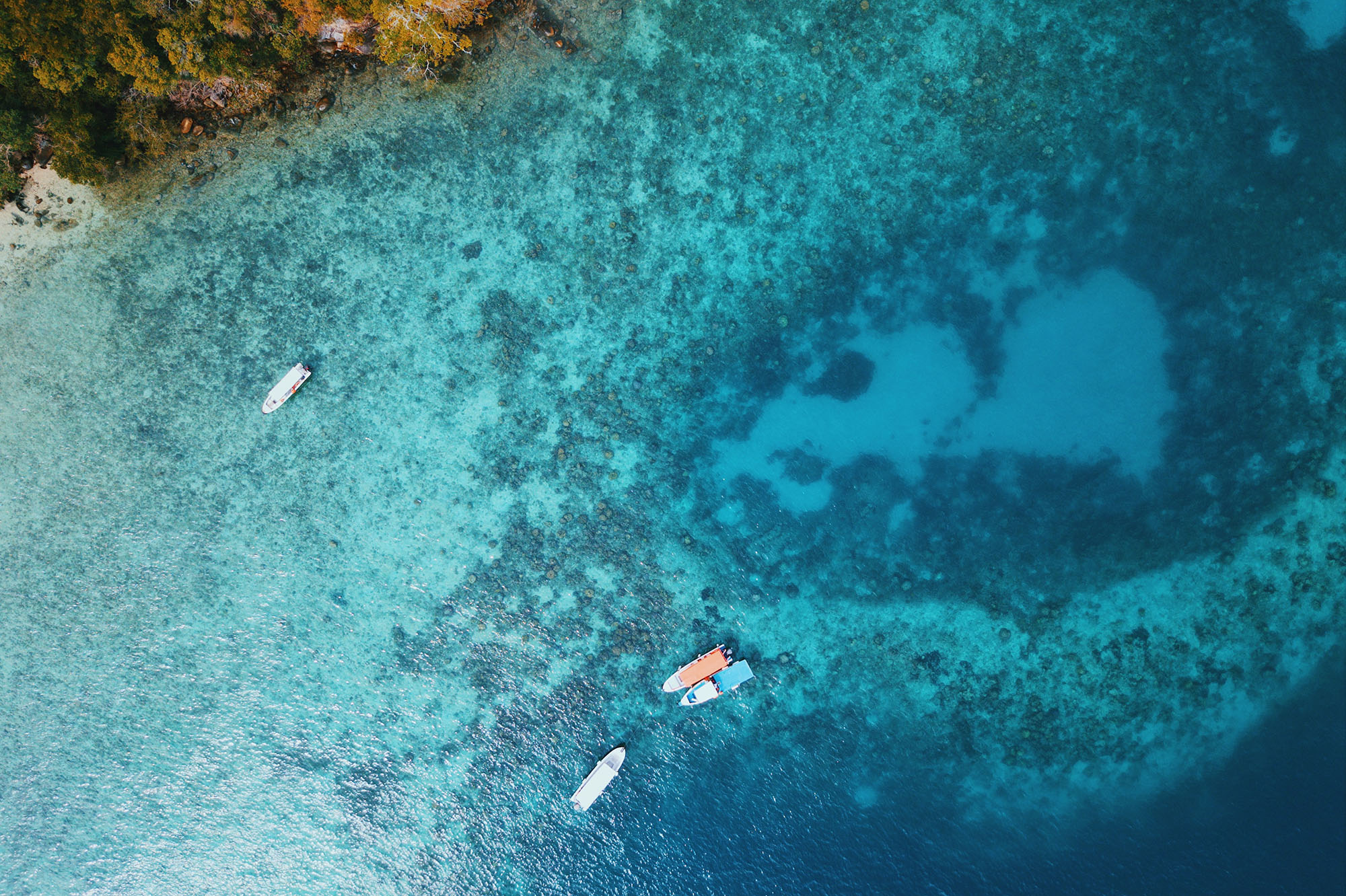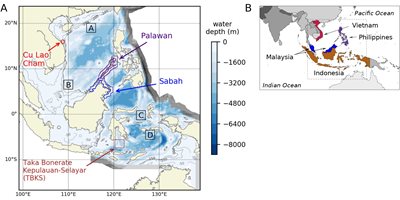Story
Projections show that the seas of Southeast Asia may warm by 1.1 to 2.9°C through the 21st century
5 April 2023
Modelling study highlights potential effects of climate change on marine ecosystems in Southeast Asian seas.

Tourist boats anchored in Sabah, Malaysia. Fahrul Azmi | Unsplash
New modelling projections show that the seas of Southeast Asia may warm by 1.1 to 2.9°C through the 21st century, with reduced oxygen levels and many other environmental changes that could cause stress for marine life.
The changes are expected to reach all parts of the water column and could have serious implications for habitats such as coral reefs, which are important nursery grounds and places of refuge for marine creatures. In addition, altered species distribution driven by these changes would have consequences for biodiversity, the livelihoods of small-scale fishers and the food security of coastal communities.
The study, undertaken as part of the Global Challenges Research Fund (GCRF) Blue Communities Research Programme and led by Plymouth Marine Laboratory, covered four sensitive coastal sites of key importance for biodiversity and sustainable development: UNESCO Biosphere Reserves at Cu Lao Cham-Hoi An (Vietnam), Palawan (Philippines) and Taka Bonerate-Kepulauan Selayar (Indonesia), and the coastal waters of Sabah (Malaysia), which include several marine parks.
 The seas of Southeast Asia are home to some of the world’s most diverse ecosystems and resources that support the life and livelihoods of millions of people. In some Southeast Asian countries, the ocean economy can account for 15-20% of total GDP but the region as a whole is particularly vulnerable to the effects of marine climate change, with large populations living in coastal areas and relying heavily on marine resources and marine ecosystem services.
The seas of Southeast Asia are home to some of the world’s most diverse ecosystems and resources that support the life and livelihoods of millions of people. In some Southeast Asian countries, the ocean economy can account for 15-20% of total GDP but the region as a whole is particularly vulnerable to the effects of marine climate change, with large populations living in coastal areas and relying heavily on marine resources and marine ecosystem services.Climate change will bring temperature changes, acidification, deoxygenation, sea-level rise and other environmental changes with uncertain consequences for human and natural systems, which is of particularly relevance to the tropics as changes here are likely to exceed natural variability first.
Even so, there has been little regional-scale climate modelling of the marine ecosystem in this area of the world, which could help us to gain a better understanding of how these changes may impact the environment and wider society. Projections of the type presented in this study serve as a key tool for communities, policymakers and regulators to help develop adaptation strategies to address the challenges bought on by climate change, whilst still allowing for sustainable development in the region.
The team focused the modelling on a mid-range greenhouse gas scenario (RCP4.5), under which atmospheric carbon dioxide concentration rises until mid-century and then stabilizes, and a high-range scenario (RCP8.5), with concentrations rising throughout the 21st century. The projections were created using the Proudman Oceanographic Laboratory Coastal Ocean Modelling System (POLCOMS) coupled to the European Regional Seas Ecosystem Model (ERSEM). Together, these simulate the movement of water, energy and dissolved and suspended material through the sea and the cycling of nutrients and carbon through the marine ecosystem.
.jpg?width=300&height=159) The modelled results showed that sea surface temperatures could rise by 1 to 1.5°C by mid-century and 2 to 3°C by end of the century under RCP8.5, when compared to sampling datasets from 2000-2019. Smaller increases were projected under RCP4.5, with mid-century increasing by 0.5 to 1°C and end of the century by 1 to 1.5°C. These results imply that temperatures that were average for the region in 2000-2019 would occur only in the very far north by the end of the century under RCP8.5. Change under RCP4.5 was smaller but still showing end of the century conditions similar to those at mid-century under RCP8.5. Among the sample areas, the largest temperature changes were seen in the centre and south: Palawan, Sabah and Taka Bonerate-Kepulauan Selayar.
The modelled results showed that sea surface temperatures could rise by 1 to 1.5°C by mid-century and 2 to 3°C by end of the century under RCP8.5, when compared to sampling datasets from 2000-2019. Smaller increases were projected under RCP4.5, with mid-century increasing by 0.5 to 1°C and end of the century by 1 to 1.5°C. These results imply that temperatures that were average for the region in 2000-2019 would occur only in the very far north by the end of the century under RCP8.5. Change under RCP4.5 was smaller but still showing end of the century conditions similar to those at mid-century under RCP8.5. Among the sample areas, the largest temperature changes were seen in the centre and south: Palawan, Sabah and Taka Bonerate-Kepulauan Selayar.Increased temperature and reduced salinity, as seen in these projections, may also result in a higher frequency of harmful algal blooms (HABs). The consequences of such HAB events include reduced water quality and toxin build-up in fish and shellfish, with potential impacts for human health and food security.
Changes in the biological system (plankton biomass, primary production) are projected to be smaller than in physical and chemical conditions but are still significant in some places, especially for the more extreme RCP8.5 scenario.
Dr Susan Kay, lead author on the study, Work Package Leader on Blue Communities and Numerical Modeller at Plymouth Marine Laboratory, commented: “The model outputs showed considerable variation between the different sample areas, emphasising the value of and need for dedicated regional ecosystem modelling that can effectively incorporate different spatial scales, water dynamics and biogeochemical processes. Examples of such differences include tidal mixing, river inputs, the interaction of multiple plankton types and supply or shortage of a range of nutrients.”
Dr Amy Then, co-author, Work Package Leader on Blue Communities and Senior Lecturer at the University of Malaya, said: “Warming waters mean that by the end of this century some parts of our Southeast Asian seas may experience average temperatures not seen in the region at present. Fish and other animals that live at or near the sea floor are particularly likely to experience conditions of temperature, oxygen and pH outside the current range of variability, to which they may not be adapted. It is critical to understand the potential changes and what they may mean for our marine environment and the millions of people that depend on healthy, diverse and productive seas.”
The paper also suggests direction for future research in this area, such as using a range of global models and regional models with different biogeochemical components to provide more definitive confidence levels. A further aspect of regional modelling that would benefit from additional attention is future changes in storminess. This is of high concern for people in the region especially considering that climate change may result in increased intensity and frequency of typhoons and flooding in SE Asia but further research is needed.
Related information
Full paper: Projected effects of climate change on marine ecosystems in Southeast Asian seas